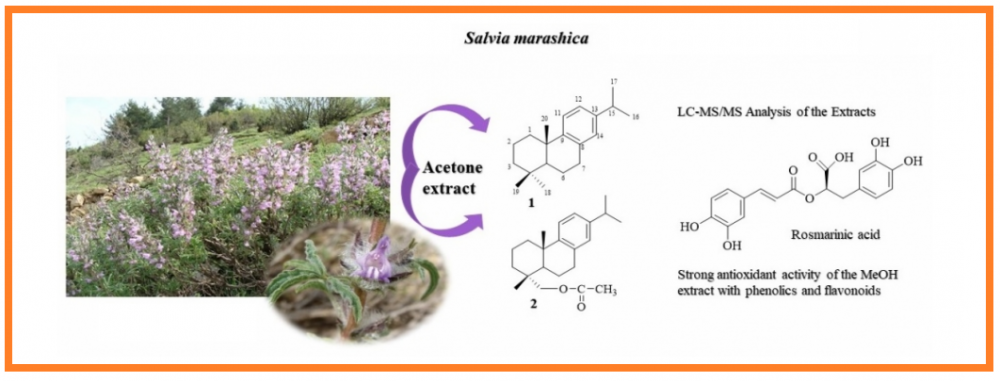JOURNAL 2003
Records of Natural Products
Year: 2021 Issue: 6 November-December (Special Issue Dedicated to the Memory of Professor Ayhan Ulubelen)
p.463 - 475
Viewed 2689 times.
-
Sibel Kıran Aydın

-
Abdulselam Ertaş

-
Mehmet Boğa

-
Ebru Erol

-
Gülbahar Özge Alim Toraman

-
Tuba Kuşman Saygı

-
Belkıs Halfon

-
Gülaçtı Topçu

GRAPHICAL ABSTRACT

ABSTRACT
In this study, dichloromethane, acetone, and methanol extracts of the aerial parts of the Salvia marashica plant which is an endemic species to Anatolia, were investigated. The total phenolic amounts of these extracts were determined as pyrocatechol equivalent and total flavonoids as quercetin equivalent. Antioxidant activity was determined by four complementary methods including inhibition of lipid peroxidation (by β-carotene color expression), DPPH free radical scavenging activity, ABTS cation radical scavenging activity and CUPRAC methods. Anticholinesterase activity of the extracts was investigated by the Ellman method against acetylcholinesterase (AChE) and butyrylcholinesterase (BChE) enzymes. Viability and cytotoxic activity tests were carried out on the fibroblast L929 cells and cytotoxic A549 lung cancer cells, respectively. The triterpenoids and diterpenoids constitute the major secondary metabolites of the S. marashica acetone and methanol extracts isolated by chromatographic methods. Their structures were determined based on spectroscopic methods, namely NMR and mass analyses. Ten terpenoids were obtained from either acetone or methanol extracts of the S. marashica. Seven of them were triterpenoids, elucidated as lupeol, lupeol-3-acetate, lup-12, 20(29)-diene, lup-20(29)-ene, α-amyrin-tetracosanoate, oleanolic acid and ursolic acid besides a steroid β-sitosterol. Two abietane diterpenes, abieta-8,11,13-triene (1) and 18-acetoxymethylene-abieta-8,11,13-triene (2), were obtained from the acetone extract which were isolated from a Salvia species for the first time in the present study. The methanol extract was found to be very rich in rosmarinic acid determined by LC-MS/MS analysis.
KEYWORDS- Salvia marashica
- terpenoids
- flavonoids
- NMR
- LC-MS/MS
- bioactivity